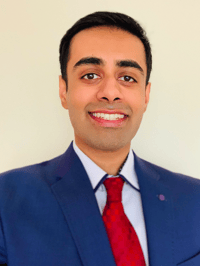 Q&A With Dr. Arun Chandra
Q&A With Dr. Arun Chandra
Earlier in the year, Arun Chandra, MD, joined Prevounce as the company's clinical lead. In this interview, he explains why he is passionate about chronic care management and healthcare technology, the role he believes healthcare technology should be playing in supporting patients with chronic conditions, and why he welcomed the opportunity to join Prevounce.
Q: What is your medical background?
Dr. Arun Chandra: Medicine was always in the back of my head, but I didn't necessarily think I was going to pursue it as a career. My medical journey started at Caltech where I gained a passion for clinical science and medical technology. I decided to take the clinical medicine route and pursue my medical degree at the Johns Hopkins School of Medicine. I wanted to earn my MD to get the clinical training that would provide the skills needed to treat individual patients, but I had in the back of my mind that I wanted to have a greater impact on population health.
I set a goal of becoming a cardiac electrophysiologist and have pursued a residency at the University of Pennsylvania with plans to undergo a fellowship in cardiology and electrophysiology.
Q: How did you develop an interest in healthcare technology?
Dr. Arun Chandra: A summer internship at Lightspeed Venture Partners during my junior year at Caltech exposed me to many health information technology companies in the San Francisco Bay Area. Lightspeed had invested in a lot of technology companies, including some of the larger tech companies on the West Coast.
After finishing at Caltech, I continued my medical training at Johns Hopkins and joined a company, Fable, that was very involved in chronic care management, medication reconciliation, and medication management space. This company developed amazing healthcare technology for bettering the lives of patients by making the transition from hospitals to the outpatient environment more seamless. I saw great merit in the company's ideas and everything they were about. I worked with this company for more than five years. In my role as a clinical project manager, I learned about the intricacies of Medicare reimbursement, chronic care management, transitional care management services, and other related areas. This served as a huge bridge to my work today at Prevounce.
Q: While at Fable, you helped design chronic care management and medication management technology. Why did you choose to focus on these areas?
Dr. Arun Chandra: These two areas are key to patient success and decreasing hospitalizations. During my time in clinical medicine thus far, proper management of chronic conditions out of the hospital and proper management of medications have proven time again to be pivotal to positive patient outcomes.
Q: How have you seen healthcare technology help with comprehensive care management, including chronic care management and remote patient monitoring?
Dr. Arun Chandra: As a medical doctor now and when I served as a medical resident within very large hospital systems, I've seen that there are many barriers to the seamless transition for patients from the inpatient setting to the outpatient life. In addition, there are a lot of barriers that precipitate rehospitalizations in patients. There are also a lot of barriers to following up with patients when they leave the hospital and making sure they get adequate care even when they're not in the hospital or seeing a provider in the clinic.
I strongly believe that healthcare technology is and should play a very significant role in overcoming all those barriers. I've seen firsthand at Fable and now Prevounce how chronic care management and remote patient management can help provide a more seamless transition to the outpatient setting. Following up when patients are outpatients cannot be performed effectively and efficiently unless you have a structured platform designed to help providers take care of their volume of patients.
Each physician has hundreds of patients. Without a platform like Prevounce, it's almost impossible to follow up with every single patient with the frequency they need, especially if they have very bad chronic conditions. It is almost impossible to have a good understanding of health trends for your patients especially if you only see them in the clinic once or just a few times yearly. There are often lapses in care and support because there's a lack of manpower.
Healthcare technology provides a bridge to more longitudinal care. Providing patients with tools and technology so they can better connect with their care team is pivotal for reducing hospitalizations. It's also better clinically and financially for population health, for patients, and for hospitals and practices. Healthcare technology represents a potential fix to a lot of these problems.
Q: What attracted you to Prevounce?
Dr. Arun Chandra: The number one thing that brought me to Prevounce was the people. One of the leaders from Fable is here, so that was definitely a big pull. I had also gotten to know other leaders at Prevounce and could tell there was a good team here. That's important. Camaraderie and having the right people to work with set a company up for success. You can't really succeed without a solid foundation and team.
I also saw a lot of growth potential with Prevounce. I really believed and continue to believe in their healthcare technology. Even prior to me coming on, it was clear that Prevounce had this clear growth potential. The company had providers and patients they were working with and had already established a reputable line of products. Prevalence also had a very strong and ethical mission that aligned a lot with what I wanted to see in healthcare concerning bettering patient outcomes, reducing rehospitalizations, and keeping patients and hospitals happy.
Prevounce is a group of motivated and dedicated people working to make true change in the field of healthcare. I'm excited to be a part of these positive changes.
Q: What do you think makes the Prevounce platform stand out from other comprehensive care management solutions?
Dr. Arun Chandra: I think it's very easy to use. It's very well designed and is patient and provider-centric. These qualities undoubtedly help with adoption and ongoing usage.
Prevounce also has a nice bridge between remote care management and the device space. In addition to providing chronic care services, Prevounce offers (through their Pylo brand) its own in-house manufactured connected devices, such as weight scales and blood pressure monitors. This gives Prevounce an all-encompassing care model for supporting patients outside the hospital.
A lot of companies are doing one or the other when it comes to remote care management software and devices. A company will focus on software while another focuses on devices. But to work together, they need a crosswalk, and that's not always easy to do or do effectively. With Prevounce, you get preventive care, chronic care, and remote monitoring and device services all in the same place. It's a comprehensive patient wellness program.


